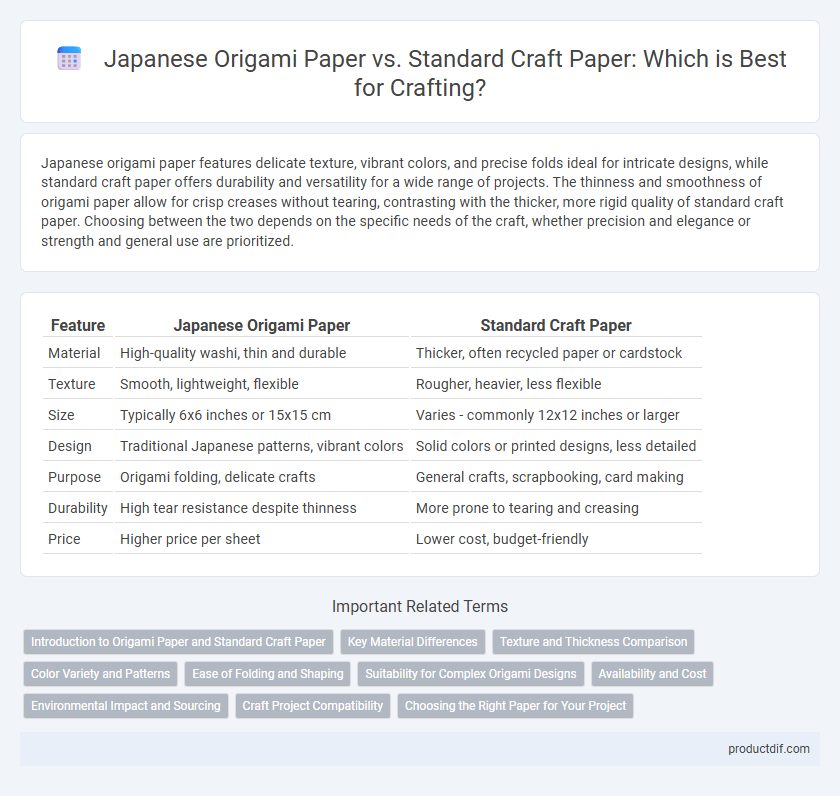Japanese origami paper features delicate texture, vibrant colors, and precise folds ideal for intricate designs, while standard craft paper offers durability and versatility for a wide range of projects. The thinness and smoothness of origami paper allow for crisp creases without tearing, contrasting with the thicker, more rigid quality of standard craft paper. Choosing between the two depends on the specific needs of the craft, whether precision and elegance or strength and general use are prioritized.
Table of Comparison
| Feature | Japanese Origami Paper | Standard Craft Paper |
|---|---|---|
| Material | High-quality washi, thin and durable | Thicker, often recycled paper or cardstock |
| Texture | Smooth, lightweight, flexible | Rougher, heavier, less flexible |
| Size | Typically 6x6 inches or 15x15 cm | Varies - commonly 12x12 inches or larger |
| Design | Traditional Japanese patterns, vibrant colors | Solid colors or printed designs, less detailed |
| Purpose | Origami folding, delicate crafts | General crafts, scrapbooking, card making |
| Durability | High tear resistance despite thinness | More prone to tearing and creasing |
| Price | Higher price per sheet | Lower cost, budget-friendly |
Introduction to Origami Paper and Standard Craft Paper
Japanese origami paper, known as "washi," features lightweight yet durable fibers, often handmade, and is prized for its vibrant colors and intricate patterns that enhance paper folding precision. Standard craft paper typically consists of thicker, more rigid pulp-based sheets designed for general crafting needs, offering a more affordable but less flexible option. The unique texture and strength of Japanese origami paper provide superior fold retention and artistic detail compared to the utilitarian nature of standard craft paper.
Key Material Differences
Japanese origami paper, often made from washi, features a thin, strong, and flexible fiber composition derived from mulberry bark, enabling precise folds without tearing. Standard craft paper typically consists of thicker wood pulp fibers, resulting in less flexibility and a coarser texture that can hinder intricate folding. The superior tensile strength and refined texture of Japanese origami paper make it ideal for detailed origami projects compared to the more rigid and absorbent standard craft paper.
Texture and Thickness Comparison
Japanese origami paper offers a smoother, more delicate texture compared to standard craft paper, enhancing fold precision in intricate designs. It is typically thinner and lighter, allowing for sharp creases without bulk, which is ideal for complex origami models. Standard craft paper tends to be thicker and rougher, providing durability but less finesse in detailed folding projects.
Color Variety and Patterns
Japanese origami paper offers an extensive color variety and intricate traditional patterns, making it ideal for detailed folding projects and artistic crafts. Standard craft paper typically features a limited color palette with simpler, more utilitarian designs suited for general crafting purposes. The unique hues and textures of origami paper enhance visual appeal and precision, setting it apart from conventional craft paper.
Ease of Folding and Shaping
Japanese origami paper, known for its thin texture and high tensile strength, allows for precise folds and crisp creases, making it ideal for intricate designs and detailed shaping. Standard craft paper is generally thicker and stiffer, which can cause difficulty in achieving sharp folds and limit the ability to form complex shapes. The superior flexibility and smooth surface of origami paper enhance ease of folding, reducing paper tear and ensuring better structural integrity in finished crafts.
Suitability for Complex Origami Designs
Japanese origami paper, known as "washi," offers superior thinness and durability, making it ideal for intricate and complex origami designs requiring precise folds. Standard craft paper is often thicker and less flexible, which can result in difficulties when executing detailed origami models. The textured surface and tensile strength of Japanese origami paper enhance fold accuracy and reduce tearing, significantly improving overall craftsmanship for advanced origami projects.
Availability and Cost
Japanese origami paper offers vibrant colors and traditional patterns but is generally more expensive and less widely available compared to standard craft paper. Standard craft paper is sold in bulk at a lower cost, making it more accessible for large-scale projects and everyday crafting needs. Availability of Japanese origami paper is often limited to specialty stores or online retailers, whereas standard craft paper can be found in most general craft supply shops.
Environmental Impact and Sourcing
Japanese origami paper is often crafted from sustainable fibers like washi, derived from renewable resources such as mulberry trees, promoting eco-friendly sourcing practices. Standard craft paper typically relies on wood pulp from large-scale industrial forestry, which may contribute to deforestation and higher carbon emissions. The biodegradable nature of washi origami paper reduces environmental impact by minimizing landfill waste compared to some standard craft papers coated with synthetic additives.
Craft Project Compatibility
Japanese origami paper offers superior flexibility and precision for delicate fold-based craft projects compared to standard craft paper, which tends to be thicker and less pliable. Its thin texture and vibrant patterns enhance the aesthetic appeal and accuracy of intricate designs, making it ideal for detailed origami and paper sculptures. Standard craft paper, while more durable, is better suited for general crafting tasks like scrapbooking, card making, and mixed media projects where rigidity is beneficial.
Choosing the Right Paper for Your Project
Japanese origami paper offers superior crispness and intricate patterns, making it ideal for detailed folding projects requiring precision and aesthetic appeal. Standard craft paper, typically thicker and more durable, suits general crafting tasks such as scrapbooking or card making where sturdiness is essential. Selecting the right paper depends on project needs: opt for Japanese origami paper to achieve delicate folds and vibrant designs, while standard craft paper provides versatility and resilience for varied creative applications.
Japanese origami paper vs Standard craft paper Infographic

 productdif.com
productdif.com